Once upon a time, when I was a kid (ok, back in the late 1900’s – like, 1999 – when I wasn’t really a kid), I came across The A-Z of Bullions on my sister’s bookshelf.
My next-oldest sister has always been My Hero when it comes to churning out arts, crafts, real cooking, and pretty much All Things Handmade. If she turns her hand to something that requires Making, she’s generally successful at it.
Heirloom sewing (this hand embroidered First Communion dress, for example) was one of her first loves. Long before I ever got into real embroidery, she was stitching bullion knots on her children’s clothes.
But then, that’s because she’s So Much Older than I am.
Chortle, chortle.
It’s no wonder, then, that, once upon a time back in 1999, I found the A-Z of Bullions on her bookshelf.
And given my growing infatuation with embroidery, it’s equally no wonder that I absconded with it.
This is the book that taught me how to work bullion knots easily and with confidence.
And it’s one of the many A-Z books that have been recently republished by Search Press, this one under the title of A-Z of Embroidered Motifs.
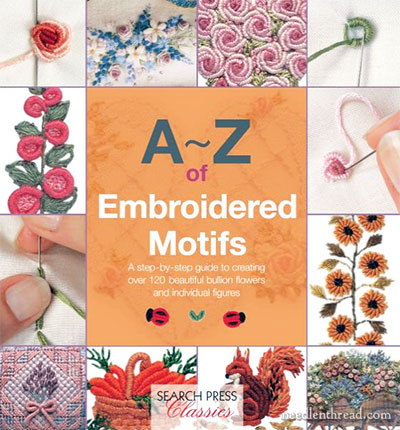
A-Z of Embroidered Motifs, newly republished by Search Press, focuses primarily on small embroidered motifs and vignettes that incorporate bullion knots.
The book appeals to embroiderers from lots of different angles. If you’re a crazy quilter, if you like dimensional embroidery, Brazilian embroidery, stumpwork, and the like, if you love to stitch gardens, or if you just like stitching small things here and there, now and then – you’ll love this book!
The book begins with the basics, including general information on threads, needles, fabrics, hoops, how to transfer designs, and tips for lefties.
From there, it launches into step-by-step instructions for starting and ending threads, and for working various types of bullion knots – the basic bullion, bullion loops, couched bullions, tapered bullions, very long bullions, and different bullion roses.
Throughout the book, you’ll find short articles on bullion embroidery from various contributors, like Kris Richards, Lesley Turpin-Delport and Susan O’Connor.
The rest of the book? It’s devoted to the motifs, of course!
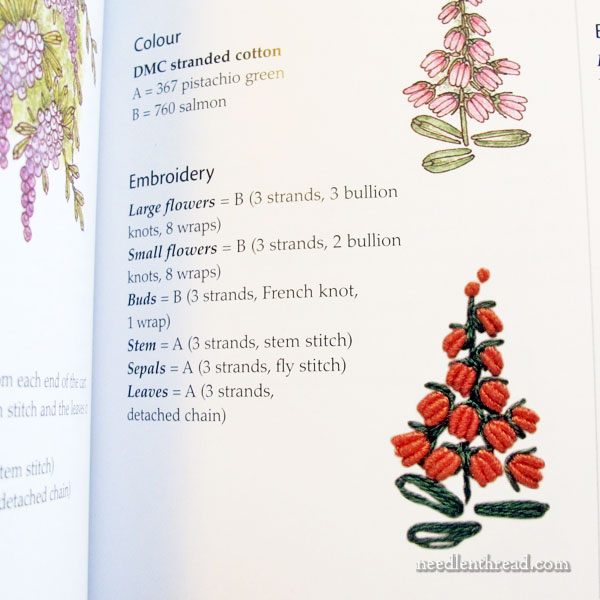
The motifs are divided into the following types: An alphabet, animals, Australian animals, Christmas, Flowers, Food, Miscellaneous, Nursery, Roses, and – (no, really!) – Transport.
Transport might sound like a strange category for embroidery, but it’s filled with delightful little transportation-related motifs, from sailboats to airships (or blimps) to hot air balloons, bi-planes, helicopters, and rockets!
Each motif in the book is accompanied by a materials list (if you want to re-create it exactly as shown in the book), a stitch layout guide (what stitches are used where), a pattern, a photo of the finished motif, and, often, a small watercolor rendition of it.
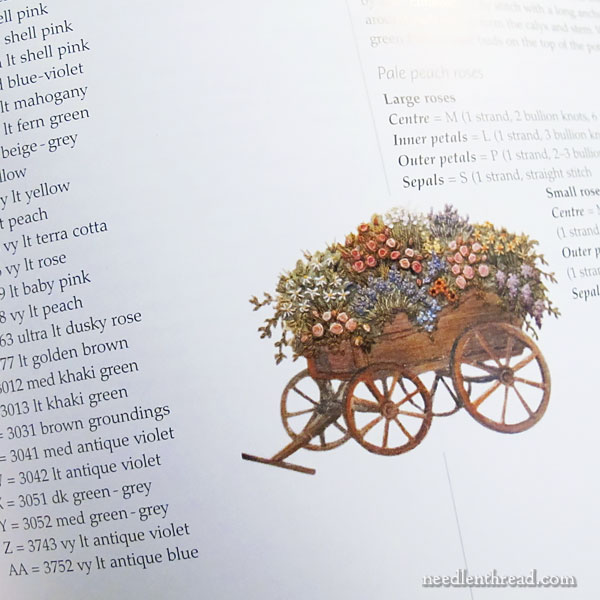
Some of the motifs are larger than others and can stand alone as little embroidery projects, like the flower cart above…
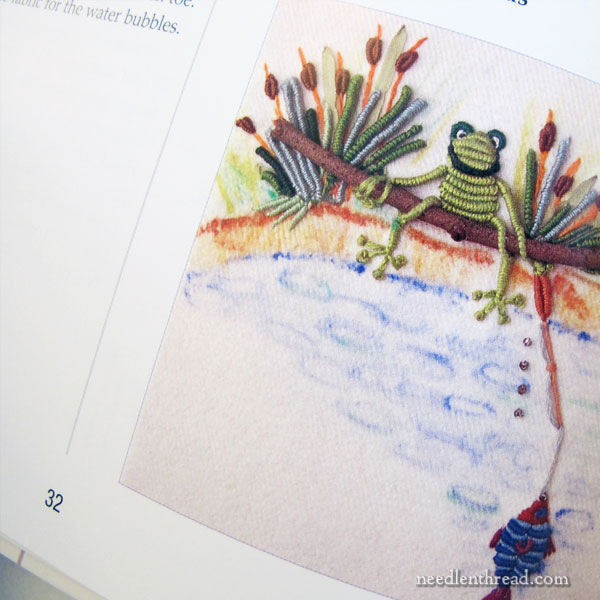
…or – my favorite! – the fishing frog.
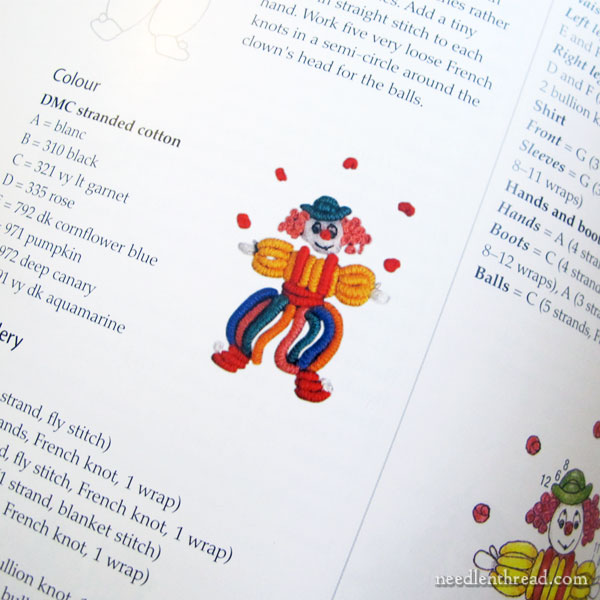
Other motifs are smaller, perfect for accenting children’s clothing, for adding to larger projects like samplers or embroidered gardens, for making embroidered ornaments and the like, or just for a little special embroidered touch on… just about anything!
The animals in the book, by the way, are all just adorable – from cats to butterflies, bees to squirrels, ladybugs, poodles, ducks, bunnies, sheep, lions, wombats and more – there are heaps of bullion animal motifs!
In the back of the book, you’ll find a section of clear line drawings for each motif, so that you can trace out guidelines on your fabric.
All in all, A-Z of Embroidered Motifs is a jolly fun book! The instruction is excellent, and with over 120 motifs to embroider, it offers a glorious amount of stitching entertainment!
Pros & Cons, in a Nutshell
Pros:
In the book, you’ll find great instruction on all kinds of bullion knots, used in all kinds of ways. You’ll find lots of little designs that can be used individually for quick projects or that can be grouped together into your own design concoctions. And of course, the book is beautiful.
Cons:
The book does not instruct on any other stitches used in the various motifs. There aren’t a lot of other stitches used, though. Those that are, are basic stitches (in fact, you can find instructions for all of them here on Needle ‘n Thread, for free). If you have a stitch dictionary on hand or access to the internet, this won’t really be a drawback.
Where to Find A-Z of Embroidered Motifs
If you happen to have a local needlework shop that caters to a broader spectrum of stitching interests than most, you might find it there.
But if you’re like me and you have to seek out your embroidery supplies online, you can find A-Z of Embroidered Motifs through the following book affiliates:
In the US, A-Z of Embroidered Motifs is available through Amazon.
Worldwide, you can find A-Z of Embroidered Motifs through Book Depository, with free delivery.







Thank you Mary! Helpful review & even better, your link to Lesley Turpin- Delport. There’s some really delicious stuff there. Have you used her threads & will you review them? The link to Susan O’Connor didn’t work for me so I will search separately for her. Thanks again for sharing resources & eye candy!
Hi, Susan – I think their website must be undergoing technical difficulties all around. It won’t come up at all without a fatal error. Yesterday, the link worked, though, so when they get the site fixed, I’m sure it’ll work again. Strangely enough, the old Country Bumpkin link to the PDF download (by Kris Richards) works fine. But the Inspirations Magazine site is not coming up. Looks like a coding error of some sort.
That book would be a death wish for me……….. I detest bullion knots in general, they are a nightmare to do with stranded floss, which is what I use all the time when I embroider. (Yes, I used a milliners needle every few years when I attempted to teach myself to do them.) I notice that they appear to work fabulously with (round and thick) non-stranded stuff (I have seen several others, and videos, do them) but never with stranded which is what I use. The last time I tried was with two strands of floss (DMC) and I wasted about three hours and made a total of about 14 or 15 knots. It was an absolute frustration because the needle would not pull out of the wraps (unless I used my pair of pliers)unless there was fewer than four wraps on the needle. No, I did not wrap them tight, and no, I was not holding the wraps tight either. I was even making sure that it was not tight because of the tightness problem. The needle would not even slide out if I was not holding the wraps, just the end to keep the wraps from unravelling. The floss would slide fine, once the needle had passed through the wraps, but the wraps would spread out an inch or more and I would have to use another needle to reorganize them before I finished the knot. Those knots are a huge headache so, sadly, I gave up bullion knots forever a couple of years ago. Any ideas?
Have you watched my video? I don’t double pierce the fabric – I just stick the needle up into the fabric and work with it straight up. It’s much easier to hold the wraps in place while you pull through, gripping the whole needle. I think bullions look terrific with stranded floss, so if you can get the process down, you’ll love the look! And once you get the process down, it really does seem like second nature to work a neat knot…
Yes, I have seen your video, the fact that it was different was why I used it last time… I think I need a third hand or something… Thanks.
Hello RMW, I have the same trouble with bullions, but if you feel the need for a third hand, have you tried using a seat frame? I found it took a little while to get used to it, but now I love it. If you’re in the UK they are made by Elbesee, who make wooden hoops. I don’t know about the USA but they must be available there too.
Yes, Mary, I guess you were a bit of a miracle child, coming along so many years after your sister!
Is this book exactly the same as the first A-Z of bullions, which I have, or is there new material too? Thanks!
It’s the same book, Monica – if you already have the bullions book, you’re good!
You are such a temptress Mary Corbet! As if I needed books!
Dear Mary
I’ve just ordered the book as I really like the A-Z series and I like bullion stitch and I love the flower cart it’s lovely, I also like the idea of all the patterns being at the back so convenient. I can’t wait to receive it. The clown motif is adorable and it would look lovely on clothes or other items of clothing and accessories for children. Thanks so much for reviewing the A-Z Embroidery Motifs and for sharing your views on it with us. I hope you have a great weekend.
Regards Anita Simmance
I love the flower cart as well, it’s the kind of thing I’d love to be able to do – so pretty.
I will look into getting this book, but I’m having the same problems as RMW, who commented above. I just cannot get the knack of bullions at all. I recently made your Lavender Honey needle book and I had to do the bees another way. they still look cute, but I’m disappointed that I can’t do bullions nicely. I also found it hard to thread the straw needles as they have such a small eye compared to crewel needles. Thanks for your site, Mary. It’s such a wonderful resource.
regards
cheryl
UK
Hi, Cheryl – Bullions do take a little practice. If you watch the video, you’ll see that I do them a little differently than you’d see them in a book. Instead of scooping up fabric, I hold the needle, pointing straight up through the fabric, from the back, and wind the thread around the needle that way. Then I hold the wraps on with two fingers while I pull through. Don’t be intimidated by them! If you pull the wraps through and they look wonky to you, you can still fix them! Just hold the stitch in your fingers and roll it back and forth. Try stroking the underside of the stitch with your needle, too, to help situate the wraps after you’ve pulled the stitch through. If the stitch is flat on the surface of your fabric, you can also roll a finger back and forth on top of the stitch. Rolling the stitch around a bit often helps the wraps settle into place. It’s a pretty sturdy stitch, so don’t feel like you have to treat it too gingerly if it isn’t doing what you want. Besides, if you figure it looks bad and you might have to cut it out and start over, then there’s no harm in roughing it up a bit to try to get it to behave. You might even consider just sitting down and practicing them, working on a piece of scrap fabric. The more you do, the better you’ll get at them.
As for the small eye on the straw needle, try a needle threader – or try a larger sized straw needle. A slightly larger needle might make it even easier to work the bullion.
How have I never heard of Book Depository before??? And FREE SHIPPING TO CANADA!!!
Mary, you are wonderful. Your blog is an amazing resource, thank you a million times for all your great videos and sharing your projects.
Thanks for the review and links. I followed Susan O’Connors and it worked for me. While I was there I found this. http://www.metmuseum.org/collection/the-collection-online/search/98291?img=5
There are 7 pictures in total. Simply beautiful and I wonder how long it took to make.
I want to purchase this book